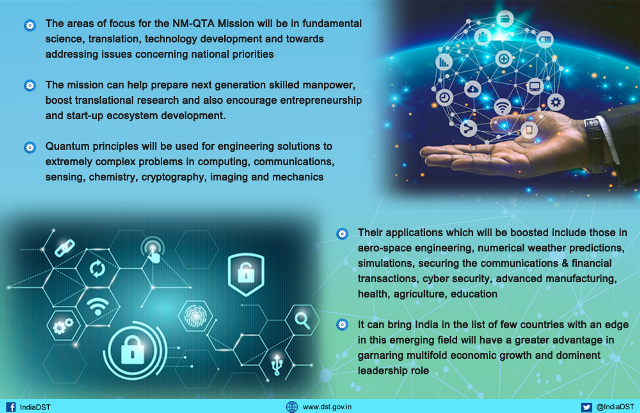National Mission On Quantum Technologies & Applications
- 07 Feb 2020
- The government in its budget-2020 has announced a National Mission on Quantum Technologies & Applications (NM-QTA) for developing quantum computing linked technologies in the country.
Aim
- It aims at harnessing the potential of QTA and keep the country in league with the ones taking the lead in the domain
Need for NM-QTA
- Quantum technology is opening up new frontiers in computing, communications, cyber security and encryption with wide-spread applications.It is expected that lots of commercial applications would emerge from theoretical constructs which are developing in this area.
- It is perceived that the countries who achieve an edge in this emerging field will have a greater advantage in garnering multifold economic growth and dominant leadership role.
- With such notion, it has become imperative both for government and industries to be prepared to develop these emerging and disruptive technologies in order to secure our communications, financial transactions, remain competitive, drive societal progress, generate employment, foster economic growth and to improve the overall quality of life.
About NM-TQA
- The mission will be implemented by the Department of Science & Technology (DST) for a period of five years.
- Focus Area:The areas of focus for the Mission will be in fundamental science, translation, technology development, human and infrastructural resource generation, innovation and start-ups to address issues concerning national priorities.
- The next generation transformative technologies that will receive a push under this mission include quantum computers and computing, quantum communication,quantum key distribution, encryption, crypt analysis, quantum devices, quantum sensing, quantum materials, quantum clock, etc.
- Digital platform will be created which will facilitate seamless application and capture Intellectual Property Rights (IPRs) and also in an institute of excellence, a centre will be established that will work in the field of intellectual property.
- Knowledge translation clusters will be set up across different technology sectors including in new and emerging sectors for designing, fabrication and proof of concept.

QuEST Programme
Broad Objectives
|
Impact
Help in Development of Next Generation Technology
- The Mission will be able address the ever increasing technological requirements of the society, and take into account the international technology trends and road maps of leading countries for development of next generation technologies.
- It will help prepare next generation skilled manpower, boost translational research and also encourage entrepreneurship and start-up ecosystem development.
Boost to Quantum Technology
- It would help develop and bring quantum computers, secured communications through fibre and free space, quantum encryption and crypt-analysis and associated technologies within reach in the country and help address India specific national and regional issues.
Bringing India in line with Advance Countries
- By promoting advanced research in quantum science and technology, India can be brought at par with other advanced countries and can derive several direct and indirect benefits, leading to overall development of country.
Quantum Technologies
- Quantum technologies comprise quantum computing, quantum communication, quantum optics, quantum information processing, quantum internet and quantum artificial intelligence.
- It is based on the principles of quantum theory, which explains the nature of energy and matter on the atomic and subatomic level. It concerns the control and manipulation of quantum systems, with the goal of achieving information processing beyond the limits of the classical world.
Quantum Computing
- Quantum computing is essentially harnessing and exploiting the amazing laws of quantum mechanics to process information.
- A traditional computer uses long strings of “bits,” which encode either a zero or a one. A quantum computer, on the other hand, uses quantum bits, or qubits.Quibits are subatomic particles such as electrons and photons.
- Operation of quantum computer is based on two key principles of quantum physics: Superposition and Entanglement.
Types
- There are three primary types of quantum computing.
- Quantum annealing
- Quantum simulations
- Universal quantum computing
- Each type differs by the amount of processing power (qubits) needed and number of possible applications, as well as the time required to become commercially viable.
Advantages
- Very Fast Performance:The basic advantage is speed as it is able to simulate several classical computers working in parallel.Exploiting the principles of quantum mechanics, they can easily tackle computational problems that may be tough for the classical computer as the size of the numbers and number of inputs involved grows bigger.
- Highest Level of Accuracy:its highest level of accuracy makes it suitable for big data handling and cases concerned with national security, cyber security, etc.
- Energy Efficient: In addition to holding the potential to solve some of the world’s most computationally challenging problems, quantum computers use significantly less energy, which could lead to lower costs.
Quantum Supremacy
|
Challenges
High Construction Cost
- The cost of construction and handling of errors in qubitsis quite huge, posing a great challenge in development of quantum computer.
- Another major obstacle in the construction of quantum computers has been the physical realisation of chips that can process qubits.
Decoherence
- To create a quantum computer, it is essential to keep an object in an overlapping state long enough to carry out the number of processes that are required. Unfortunately, this is not always possible since it continually loses this state of superposition, which is known as
- Decoherence, caused by vibrations, temperature fluctuations, electromagnetic waves and other interactions with the outside environment, ultimately destroys the exotic quantum properties of the computer.
Applications
- Optimization, planning, and logistics
- Forecasting
- Financial modeling
- Drug design and discovery
- Genomics
- Cyber security and cryptography
- Molecular modeling
- Chemistry modeling, computational chemistry
- Material design and modeling
- Aerospace physics
- Quantum simulation — simulation of physical systems at the quantum mechanical level
- Random number generation




